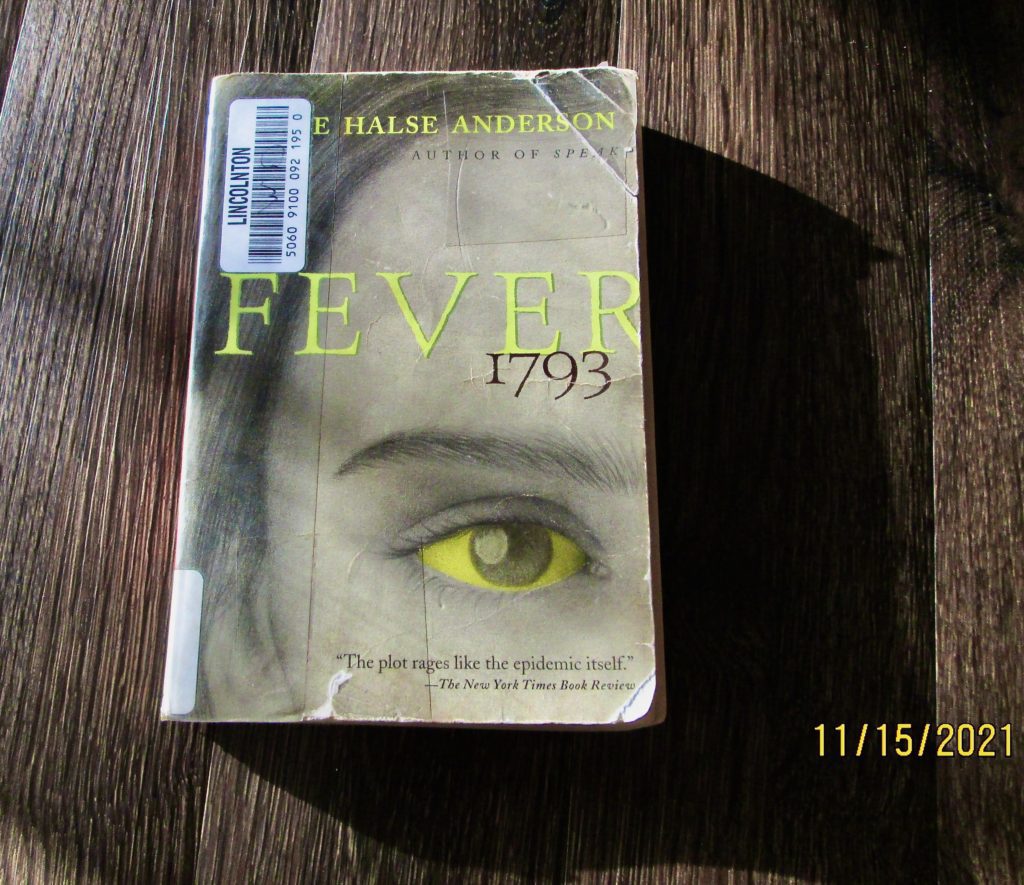
FEVER 1793, is a young adult, fictionalized account, of the yellow fever pandemic written by Laurie Halse Anderson and published in 2002. This copy was borrowed from my daughter’s extensive library. Once I started reading, I couldn’t put it down.
This is a great book for teaching teens and adults that, yes, history does repeat itself.
The heroine of the story, fourteen-year-old Matilda (Mattie) Cook and her widowed mother, with the help of her grandfather, are running a coffeehouse in Philadelphia in the year 1793. If you, like me, thought that coffeehouses are a modern day convenience, Laurie Halse Anderson shows her research in the Appendix and says, “Coffeehouses were all the rage in the 1790’s. People gathered in them to conduct business, talk politics, and catch up on the news of the day. Owning and running a coffeehouse was considered a respectable business for a widow.” (p.247)
As the epidemic of yellow fever, spread by mosquitoes in the heat of summer, overtook the city, fear led to unreasonable actions. One famous doctor of the time, Dr. Benjamin Rush, used blood letting to rid the disease from the body and the cure became the reason many died. The French doctors of the time had a different approach. They “prescribed rest, fresh air, and lots of fluids. That was the best way to treat the disease. It still is.” (p. 244)
Mattie is a young girl of fourteen, innocent, always trying to get out of work so she can enjoy her life. She has to grow up and take on the responsibilities of adulthood, with much resistance, when the fever hits.
Mattie’s mother becomes sick with the fever and keeps her hired hand, Eliza, behind to take care of her as she sends Mattie and her grandfather to the country to stay with friends. Mattie and her grandfather never make it to the friend’s house. As they are traveling, one town they need to pass through has men set up to block entrance through the area until checked by a doctor. Due to a heart condition, Mattie’s grandfather appears to have the fever and they are left on the side of the road while the ones they are riding with take off with their food and clothes.
Mattie is trying to take care of her grandfather when she falls ill with the fever. They are found and taken to a hospital where Mattie slowly recovers and grandfather is cared for. When they are able to travel, they return to their coffeehouse only to find it vacated, looted, and they have no idea if Mattie’s mother has survived or not.
Thieves break into the coffeehouse once again, and grandfather is over-stressed during the confrontation. He passes away. Now, Mattie is on her own. The decisions she makes going forward show her growing up and making adult decisions in just a few short months. She finds Eliza, takes in an orphaned girl, and together, her and Eliza take care of as many sick people as they can. A friend, Nathaniel, helps them as they reestablish the coffeehouse.
The book keeps your attention throughout as Mattie deals with one devastating episode after another. It shows her debating choices and her reliance on God and prayer to get her through.
Even though this is historical fiction, the reality of it sounds so close to today, as we deal with the Covid epidemic. In the appendix, Anderson shares this on the fear and panic of the time:
“At the beginning of the epidemic most people in Philadelphia were calm. There had been ‘fevers’ in the city before, and few thought it was anything to worry about. But as the death toll quickly rose panic took over. The fever closed businesses and the government. All anyone could talk about was ‘Who’s dead? Who’s sick?’… Although it can be hard for us to imagine, there are many reports of sick people being abandoned by their families, some thrown into the street to die. Friends and neighbors stopped talking and avoided one another on the street. Kindness seemed to evaporate. In a few short weeks the city was transformed into a living nightmare, with the sick dying, the healthy paralyzed with fear, and the doctors helpless. The brave people who stayed in the city and helped the sick were extraordinary. The volunteers of the Free African Society, those who worked at Bush Hill (a hospital set up for the sick) and the members of the Mayor’s Committee devoted themselves with incredible courage to care for strangers. They are the real heroes of this story.” (p. 251)
Heroes. That is what Mattie, Eliza, and Nathaniel, all become.
Another feature of the book that I loved is that Anderson began each chapter with a quote from journals, newspapers, letters, or records that showed the accuracy of the fictional account. One example: “Blessed be God for the change in the weather. The disease visibly and universally declines. —Dr. Benjamin Rush Letter, 1793” (p. 219)
I highly recommend this book for teens and adults who love historical fiction. It is a great book to read that shows “there is nothing new under the sun”, Ecclesiastes 1:9b. Even though the book describes a very accurate picture of 1793 historically, so many times, I felt I was reading a book set in today’s era. The book showed products we take advantage of today and an accurate account of human nature. Emotions, stress, and hardships can either bring out evil, or a hero. This book teaches how to bring out the hero.

Thank you for this review Jane!
You’re welcome!
As always, you’ve given a detailed and great review. I appreciate your faithfulness and blogs.
Thanks, Joni!
Yet another reason I love historical fiction so much. We see so much of ourselves in these stories and see that our struggles are universal and have been since the beginning. 🙂 Great review!
Absoulutely! Yes, they touch our very souls with truths from the past.